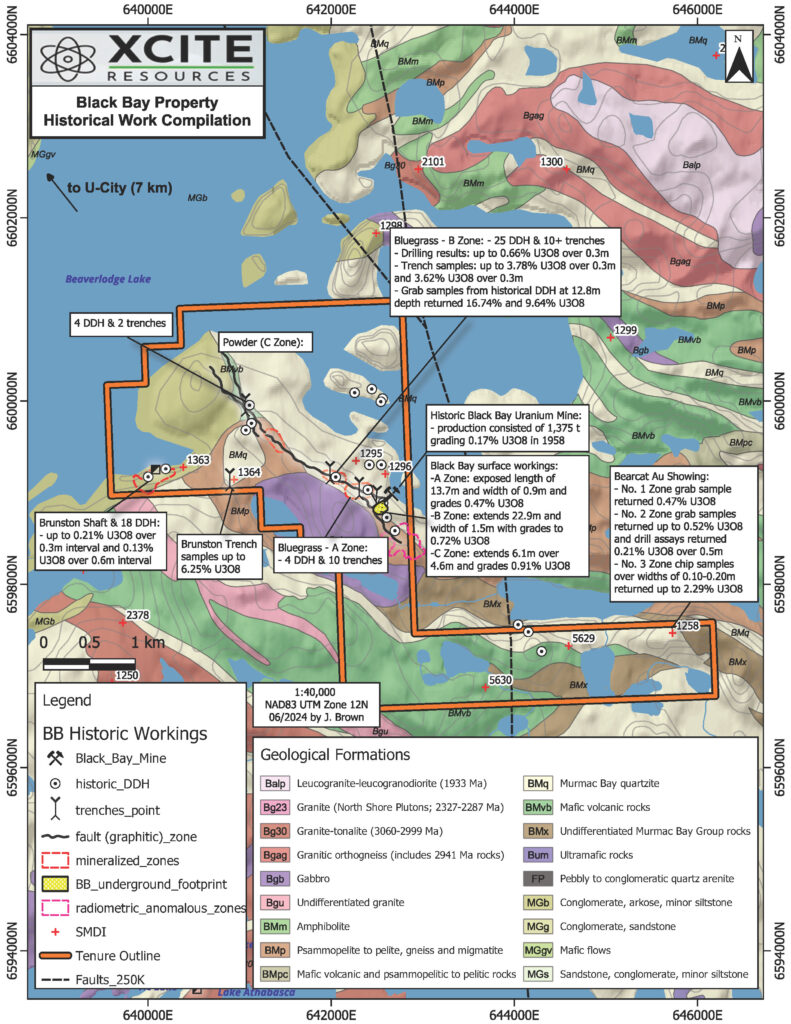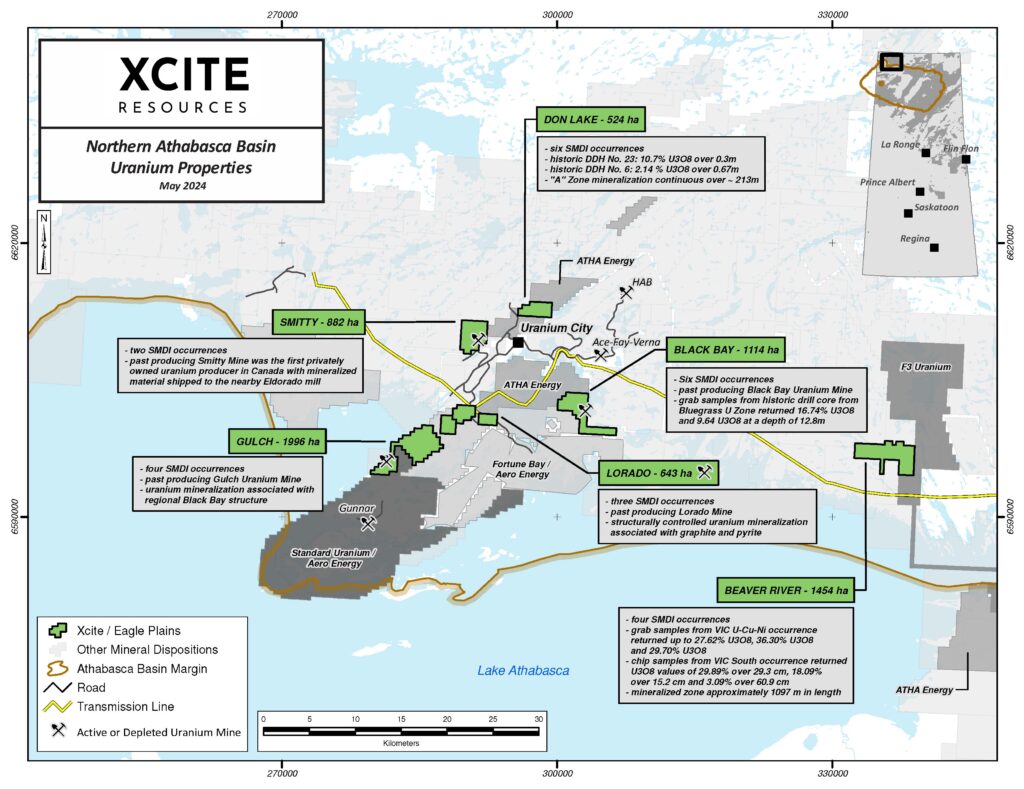Vancouver, British Columbia, June 6, 2024 — Xcite Resources Inc. (CSE:XRI) (“XRI or Xcite”) and Eagle Plains Resources Ltd. (TSXV:EPL) (“Eagle Plains”), have received the results from a data compilation on the Black Bay uranium project, located 10.9 km SE of Uranium City, Saskatchewan. The Black Bay tenures cover the past-producing Black Bay Mine as well as five additional uranium occurrences. The compilation and interpretation of available data will lead to recommendations for 2024 fieldwork.
Black Bay Data Compilation Highlights:
- Trench samples include 6.51% U3O8, 3.78% U3O8 and 3.62% U3O8 over 0.3m,
- Tenures overlie the past-producing Black Bay Uranium Mine,
- Five documented uranium and two gold Saskatchewan Mineral Deposit Index (SMDI) occurrences,
- Drill results include 0.66% U3O8 over 0.3m,
- Property hosts Beaverlodge-style basement-hosted uranium mineralization.

About the Black Bay Project
The 1,114 ha project overlies 7 Saskatchewan Mineral Deposit Index (“SMDI”) occurrences including the past-producing Black Bay Uranium Mine (SMDI 1296).
The Black Bay property geology is complex, and includes quartzites, metavolcanics, metasediments, gabbros and granitic intrusions. Uranium mineralization occurs near lithological contacts and faults, is typically present as pitchblende, and is often associated with sulphides. Vein-hosted gold mineralization is also present on the property.
Pitchblende mineralization at the Black Bay Mine occurs in drag folds along the contact zone between quartzites and gabbros and is typically associated with hematite and graphite. Several small ore shoots are developed adjacent to the contact for a strike length of 152.4 m and a down-dip distance of 731.5 m. The mineralization has a strong structural component which defines three main ore shoots, the A, B, and C Zones. The A Zone extends a length of 13.7 m and width of 0.9 m with an average grade of 0.47% U3O8. Zone B extends 22.9 m over a width of 1.5 m with an average grade of 0.72% U3O8 and Zone C extends 6.1 m over a 4.6 m with an average grade of 0.91% U3O8 (AF 74N07-0025).
Approximately 0.6 km west-northwest of the Black Bay portal is the Bluegrass Uranium Zone A showing (SMDI 1295), consisting of a brecciated zone in the quartzite adjacent to the contact with the gabbro- hosting pitchblende associated with graphite and sulphides. West of the A Zone are the B and C (Powder) Zone occurrences, along the same graphitic contact. An extensive trenching and sampling program in 1955 returned values ranging from trace amounts up to 6.51% U3O8 over 30cm from the B Zone West (74N09-0111). Other B Zone samples had average grades of 3.78% U3O8 over 0.3 m by 0.3 m (sample 710) and 3.62% U3O8 over 0.3 m by 0.6 m (sample 528). 33 diamond drill holes were completed along the Blue Grass trend, totalling 1659 m. Sample 514 from hole A-19 at the b Zone extension, assayed 0.66% U3O8 over 0.3 m (from 54.25 m to 54.55 m) (74N09-0111).
In the western portion of the Black Bay tenure are the Brunston Mining Uranium Zones No. 1 (SMDI 1363) and No. 3 (SMDI 1364). Zone No. 1 consists of scattered radioactive fractures that occur in arkose just above the Martin Formation unconformity. Diamond drilling was completed over the showing and the best assay returned was 0.21% U3O8 over 0.6 m (74N10-0138). Zone No. 3 consists of a brecciated area that hosts pitchblende within a unit of reddened quartzite containing pitchblende, sulphides and quartz. Trench samples taken at the showing returned from 0.06% to 6.25% U3O8 (SMDI 1364).
The Bearcat Showings (SMDI 1258) are located in the eastern part of the property. At the Bearcat No. 1 Zone or the Bearcat Uranium Occurrence schist-hosted uranium mineralization is exposed in a series of trenches. Grab sample U90-107 returned 0.47% U3O8 (74N09-0286). Uranium mineralization at the Bearcat No. 2 Zone is associated with sulphides, graphite and gold and occurs along a contact between a quartzite and a chlorite schist. The area has been explored with trenching and limited shallow diamond drilling. Historical results include grab samples which returned from trace values up to 0.52% U3O8, 0.34% U3O8 and 0.31% U3O8. Analytical results from hole BC-4 drilled at Bearcat No. 2 zone returned 0.22% U3O8 and 0.44% Cu from 54.5-55.0 m. Chip samples at the Bearcat No. 3 Zone over widths of 0.10-0.20 m returned up to 2.285% U3O8, 13.9 ppm Au, 80 ppb Pt and 15 ppb Pd (74N09-0286).
Black Bay History
The first period of activity at Black Bay was from the early 1950s until 1960. From 1953-1960 Black Bay Uranium Ltd. discovered and developed the Black Bay Uranium Mine, which produced approximately 1375 tons of material with a grade of 0.17% U3O8 that was shipped to the Lorado custom mill for processing. Between 1953 and 1956, Brunston Mining Company Ltd. explored their No. 1 and No.3 showings (SMDI 1363 & 1364) with a ground Geiger survey, trenching and 29 diamond drill holes totalling 1567.93 m on the Herb and Peg claims, parts of which overlap the current tenure in southwest.
In 1955, Blue Grass Uranium Mines Ltd. discovered the Bluegrass Uranium Zone (SMDI 1295), located west of the Black Bay uranium mine. Blue Grass conducted geological mapping, Geiger prospecting, trenching, stripping, and completed 1659m of diamond drilling in 33 holes. (74N09-0111). Other companies active in the area during this time included Canadian Astoria Minerals Ltd., Reward Uranium Ltd., Ebor Uranium Mines Ltd., and Scintilore Mines Ltd., which discovered the Bearcat Lake mineralization (SMDI 1258).
In 1967, Bearcat Uranium Ltd. explored the Bearcat Lake area while Majestic Mines Ltd. worked the Brunston Mining and Blue Grass areas. Bearcat carried out an airborne scintillometer survey which identified nine radioactive anomalies. Majestic completed 15 diamond drill holes (831m) across the Blue Grass B Zone and Powder Zone showings.
Saskatchewan Mining and Development Corporation (SMDC) was active in the Black Bay area in 1979 – 80, conducting work in the Bearcat showing area (74N09-0286). A ground scintillometer survey and a 92.37-line km airborne VLF-EM survey were completed, revealing numerous strong conductors along east-west oriented linear belts across the Bearcat-Mackintosh areas. This was followed up with trenching and a 16-hole, 1159m diamond drilling program. SMDC returned to the Bearcat area in 1987-88, completing re-sampling of select drill holes from 1979-80.
The next exploration in the Black Bay area occurred in 1997 when Greater Lenora Resources Corporation conducted an airborne DIGHEM-V geophysical survey over the central part of the current black Bay tenures. Several EM anomalies typical of massive sulphide responses were reported (74N-0007).
The last recorded work on the current tenures was by Dubnick in 2010 who located SMDI 5629 with prospecting.
Management of Eagle Plains and Xcite are encouraged by the tenor of mineralization displayed in trenches and historical drilling at Black Bay and believe there is significant potential for additional uranium mineralization to be discovered both along strike and to depth within known mineralized areas. Interpretation of compiled data is underway and will be instrumental in forming recommendations for 2024 fieldwork.
Rock grab samples are selective samples by nature and as such are not necessarily representative of the mineralization hosted across the property. The above results were taken directly from the SMDI descriptions and assessment reports (AF) filed with the Saskatchewan government. Management cautions that historical results were collected and reported by past operators and have not been verified nor confirmed by a Qualified Person, but form a basis for ongoing work on the subject properties.

About the Beaverlodge Uranium District
The Don Lake, Black Bay, Don Lake, Gulch, Black Bay, and Smitty projects are located in the Beaverlodge District near Uranium City in the Lake Athabasca region of Saskatchewan. Occurrences of uranium mineralization are abundant in the Uranium City area and have been explored and documented since the 1940s. The Beaverlodge camp was the first uranium producer in Canada, with historic production of approximately 70.25 million pounds of U3O8 completed between 1950-1982, with ore grades averaging 0.23% U3O8. The two largest producers were the Eldorado Beaverlodge (Ace-Fay-Verna) mine and the Gunnar uranium mine. The Beaverlodge area has seen limited uranium-focused exploration since the early 1990’s.
Xcite and Eagle Plains’ managements cautions that past results or discoveries on proximate land are not necessarily indicative of the results that may be achieved on the subject properties.
Beaverlodge-style uranium deposits host structurally-controlled, high-grade mineralization in veins and breccia-fills within basement rocks. Mineralization often occurs at geological contacts and consists of structures filled with hematite, chlorite and graphite associated with pitchblende.
Qualified Person
Technical information in this News Release has been reviewed and approved by C.C. Downie, P.Geo., a director and officer of Eagle Plains, hereby identified as the “Qualified Person” under N.I. 43-101.
About Xcite Resources Inc.
Xcite Resources Inc. (CSE:XRI) is an early-stage exploration company working to become a leader in the discovery and development of energy transition metals. The uranium project portfolio in the Athabasca Basin will propel our efforts to achieve a high-grade discovery based on new geological modeling and exploration thesis in a uranium pass producing camp dormant for 40 years. The Uranium City project portfolio constituted of the Don Lake, Beaver River, Smitty, Lorado, Gulch and Black Bay properties.
On behalf of the Board of Directors of Xcite Resources Inc.
Jean-Francois Meilleur, CEO
Contact:
Jean-Francois Meilleur
CEO, Director, and Shareholder
Xcite Resources Inc. (CSE:XRI)
+1 514 951 2730
The Canadian Securities Exchange (CSE) has not reviewed and does not accept responsibility for the adequacy or the accuracy of the contents of this release.
Cautionary Note Regarding Forward-Looking Statements:
The CSE has neither approved nor disapproved the contents of this press release. Neither the CSE nor its Regulation Services Provider (as that term is defined in the policies of the CSE) accepts responsibility for the adequacy or accuracy of this press release. This press release contains statements that constitute “forward-statements.” Such forward-looking statements involve known and unknown risks, uncertainties and other factors that may cause the Company’s actual results, performance or achievements, or developments to differ materially from the anticipated results, performance or achievements expressed or implied by such forward-looking statements.
